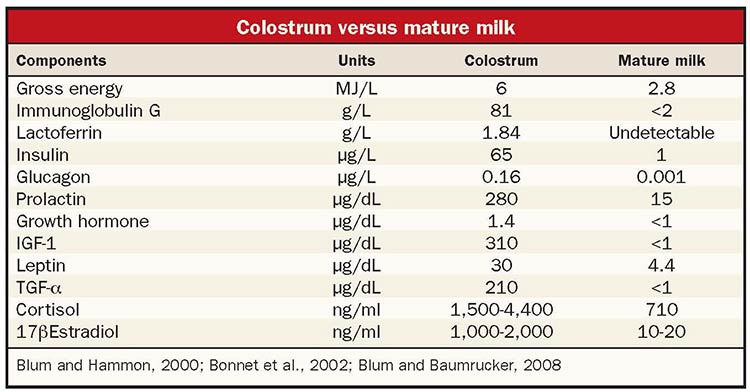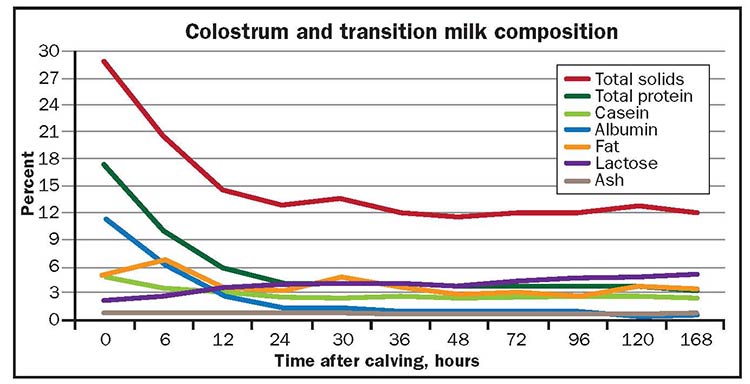
Since the objective of colostrum is to provide a minimum of 100 grams of immunoglobulins, feeding 2 quarts containing 50 grams per quart will achieve that goal. However, it is much better to provide 200 grams, which would require 4 quarts at 50 grams immunoglobulins per quart. Use of refractometers now provide a simple, quick, and fairly reliable determination of immunoglobulins per quart in colostrum.
This leads to the question: What are immunoglobulins and what are their functions? Typical immunoglobulin distribution in colostrum is about 85 to 90 percent IgG, 5 percent IgA, and 7 percent IgM. IgG is the main contributor to systemic immunity but also may function within the intestine.
IgA has a lesser role in intestinal immunity to enteric pathogens while IgM has a major role in intestinal immunity primarily through helping prevent septicemia (infection) and in immunity to enteric pathogens. Another key factor is that the sum of all Ig classes functioning together is more optimal than the purified individual Ig classes alone.
Nailing down contamination
Antibody absorption is reduced by stress, which can be from various sources such as heat, calving difficulty, rough handling, and feeding of calves. Another source that drops antibody absorption is bacterial contamination. Not only is dirty (bacterial-laden) colostrum a direct problem to the calf, but it also reduces antibody absorption. A number of field studies have found a range of 33 to 90 percent of colostrum samples exceed the upper limits of 100,000 cfu/ml for total bacteria and 10,000 cfu/ml for coliform.
The three primary sources of contamination have been found to be dirty udders, bacterial proliferation after improper storage, and dirty equipment used to milk, transfer, and feed the calf. The latter category is the most common problem source of contamination.
Colostrum should not be pooled unless it has been or will be pasteurized or heated before feeding. If fed fresh, refrigerate colostrum within two hours and use it within three days of collection. Beyond this time frame, freeze the colostrum.
When heat treating colostrum, use a well-insulated, well-stirred batch pasteurizer, which can maintain 140°F for one hour before cooling down and feeding or storing. This operation must be closely monitored, controlled, and periodically checked for efficacy by sampling and culturing both before and after processing.
An enlightening study was done about 20 years ago. A herd fed every other heifer calf born in one year either 2 or 4 quarts of colostrum at the first feeding. After that, all heifers were fed and managed the same. Those calves only fed 2 quarts had twice the veterinary costs, and at breeding age those fed 4 quarts had 0.5 pound more daily gain.
But the biggest difference was in their first lactation when those initially fed 4 quarts colostrum produced 11 percent more milk than those fed 2 quarts colostrum; and this difference in milk production grew by 17 percent in the second lactation.
Why this difference? Colostrum has been found to have over 200 bioactive compounds, which affect growth, nutrient absorption, and bacterial exclusion. Look at the table compiled by Mike Van Amburgh at Cornell University and based on various published studies.

A closer colostrum look
First, colostrum has about twice the level of solids compared to those present in normal milk. It also provides twice the level of nutrition of regular milk. Thus, in the table, the energy level in colostrum is more than double that of regular or mature milk. At 81 grams per liter, IgG indicates a high-quality colostrum versus virtually no IgG in regular milk.
Lactoferrin, which is an antibacterial, is undetectable in milk but present at a high level in colostrum. The balance of components shown in colostrum are much higher than in milk. Most of these are hormones, which are known as anabolic in that they promote growth. This reflects a newer area of science understating: epigenetics. High level of nutrition, IgG, and metabolic components may well activate more genes which facilitates growth, health, and subsequent milk production.
Some readers may remember when it was standard practice and recommendation that calves be fed colostrum and transition milk for the first three days of life. This may still be well advised.
Colostrum by definition is only the very first milking after calving. Previously, cows were milked out for three days before the milk was commingled with that of the rest of the herd.
I think this practice went away as herds got larger, and it became more troublesome to separate out and feed transition milk to calves. The graph shows that while major milk components become more normal after 24 hours, it does not show bioactive compounds that could still be present at intermediate levels but not be as obvious as the other major components of milk.
To the value of colostrum, now add findings from the University of Alberta scientists’ presentations at the 2017 American Dairy Science Association (ADSA) annual program. Their findings suggest that feeding dairy calves colostrum immediately after birth can improve the passive transfer of IgG and the colonization of beneficial bacteria in the colon.
Both characteristics are hypothesized to assist in protecting the calf from enteric infections during the preweaning period. Findings from another study indicated that the colonizing microbiome is an essential factor regulating the rapid development of the mucosal immune system during the first week of life.
Not only does colostrum have value for its antibody absorption by the calf, but its many bioactive compounds have positive effects on growth, nutrient utilization, and subsequent milk production. These compounds and nutrient levels would be intermediate in transition milk. So, if you can, also feed transition milk to calves for their first three days of life.











